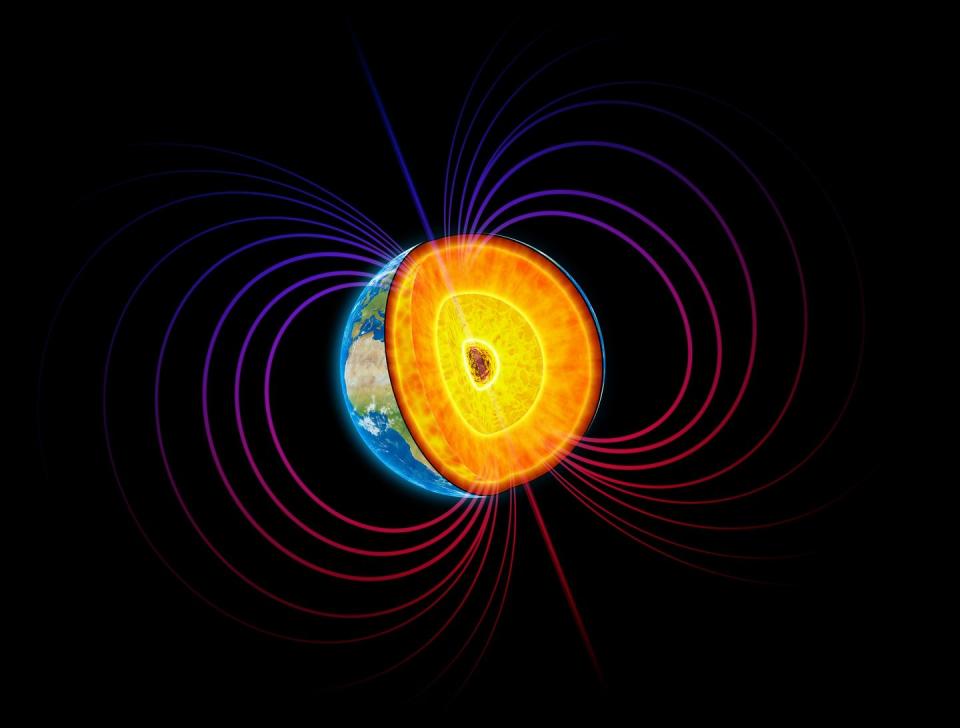Why the World We Live In Is Powered By Magnets

Ah, magnets. Refrigerators are full of ’em. They power our Netflix binge-sessions. When broken down into tiny pieces and smashed into Silly Putty, they can provide hours of fun.
Magnetism is the force exerted by magnets, objects that repel or attract each other. This powerful physical phenomenon is one component of electromagnetism, one of the fundamental forces of nature.
The motion of electrically charged particles found in all matter gives off electric currents that create a magnetic field. These particles become tiny magnets, each with north and south poles. Technically, all matter is subject to the magnetic forces that pervade our universe. Some of these effects are more obvious than others, according to the BBC.
Often, the magnetic fields generated by these particles are random, meaning their north and south poles cancel each other out. Some objects—from hunks of iron ore to the alphabet magnet stuck to your fridge—have magnetic fields that are arranged in the same direction. The magnetic fields of these objects become stronger as the velocity of these electrically charged particles increases, according to Live Science.
Magnetism is a mysterious force in this universe. Scientists don’t fully understand why it occurs in the first place. They aren’t sure why these particles have a north and south direction either, according to Live Science, and there are many different forms of magnetism.
Mysterious Forces

Ferromagnetism, the strongest form of magnetism, occurs when materials are exposed to an external magnetic force, according to Georgia State University’s HyperPhysics website. These objects become permanently magnetized, through a process called hysteresis. Early iron compass needles were magnetized by lodestone or magnetite minerals pulled from the Earth. This is the only magnetic force that humans can tangibly feel.
Ferromagnetism may be the most noticeable form of magnetism, but electromagnetism is arguably the most important. It is the fundamental force “responsible for the very structure of our matter,” astronomer Michele Thaler of NASA’s Goddard Space Flight Center told the Science Channel.
💡The other fundamental forces are gravity, weak nuclear, and strong nuclear.
Electricity and magnetism are closely intertwined, and their respective fields feed off of and interact with one another. Electromagnetism creates light and energy, and without it, the atoms and molecules we’re made of would fall apart. In 1865, physicist James Clerk Maxwell drew the connection between these twin forces, setting the stage for Einstein to form his famed theory of special relativity.
Of course, the applications of electromagnetism in everyday life are vast. It powers everything from microwave ovens and television sets to radios and x-ray machines. When an object is exposed to an electric current, it generates a temporary coil-shaped magnetic field. When that current is shut off, however, the field disappears. This is called an electromagnet.
Have you checked Twitter today? Driven a car? Binged a new show lately? The world we live in is powered by these electromagnets.
The Magnet Beneath Your Feet

Earth is essentially a giant magnet with corresponding geomagnetic north and south poles, thanks to our molten iron outer core. The teardrop-shaped magnetic field Earth generates, which is squashed by solar winds and called the magnetosphere, ensures that our compasses work, provides for brilliant aurorae, and even protects us from harmful cosmic radiation. It’s critical to the protection of our coveted atmosphere.
Magnetized particles in lava rocks along Earth’s surface record the direction of our planet’s magnetic field. This is how scientists are able to tell that Earth’s magnetic poles have switched over time and that the tectonic plates on which we live incrementally move, according to National Geographic.
In recent years, Earth’s shifting magnetic poles have been picking up the pace. Some studies have shown that they’re traveling as quickly as 35 miles per year. This can disrupt navigation systems and cause headaches for travelers.
Our fascination with magnetism stretches back for thousands of years. Mesoamericans developed an early understanding of the force and the Greeks were the first to document its wonders. That fascination hasn’t dwindled over the years. Our understanding of magnetism has been critical in shaping the world we live in today.
Without it, we would be lost. Literally.
You Might Also Like

